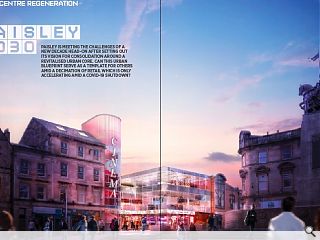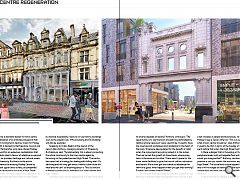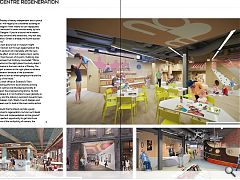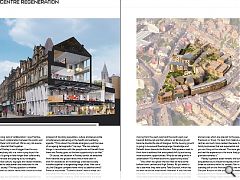Town Centre Regeneration: Paisley 2030
15 Apr 2020
Paisley is meeting the challenges of a new decade head-on after setting out its vision for consolidation around a revitalised urban core. Can this urban blueprint serve as a template for others amid a decimation of retail which is only accelerating amid a Covid-19 shutdown?
Paisley has become a standard bearer for town centre renewal with publication of an ambitious blueprint that sets out to arrest its long-term decline. Vision for Paisley Town Centre 2030 is backed by Renfrewshire Council and Scotland’s Town Partnership, who have chosen Paisley as a proving ground for an audacious revitalization that sacrifices lame duck retail in favour of adaptive re-use and a renewed focus on priceless heritage and cultural assets.
Written by Threesixty Architecture the action plan seeks to enhance the existing Paisley Centre by repurposing vacant upper units as flats, accompanied by a range of new attractions including a High Street cinema and food hall. This town centre first approach will consolidate remaining street-front retail on High Street while establishing new public spaces, lanes and streets to improve accessibility. Ideas to re-use historic buildings such as the Liberal Club, YMCA building and TA Building will also be explored.
Speaking to Urban Realm at the launch of the report Alan Anthony, managing director of Threesixty Architecture, said: “Fundamentally this is about connecting the whole community to the town centre again by focussing on the pedestrianised High Street. The centre has never had a strategy for dealing with falling retail. It’s declining and will only get worse, there’s a dire future for retail and we can’t do anything about it. This is a once in a lifetime opportunity to rebalance our town centres and High Streets.”
Turning a crisis into an opportunity is a well-worn tactic in times of strife but is a change in perspective enough to reverse decades of decline? Anthony continued: “The opportunity is to say the town shouldn’t be dominated by retail anymore because it never used to be. It used to have the cinemas and workplaces and residential in the heart of the town. It became depopulated for the benefit of retail when the consumerist economy kicked in in the sixties. Then we’ve had the growth of clone towns where every town is the same as the other. There wasn’t space for the lower rental facilities to give that mix of culture, education and leisure. We’ve now got the chance to rebalance the town and guess what happens when you get that working? Footfall, who needs footfall? Retail.”
This circular thinking brings to mind the Ouroboros but Anthony is adamant that this approach won’t result in the town merely cannibalising existing assets but rather deliver a net increase in people and businesses, no-one travels to Paisley to see a Tesco’s after all. “This is a reawakening of what a town centre should be”, says Anthony. “Not what it used to be. Not in terms of the heyday of retail but what went before that when the High Street had three cinemas.”
Is there a danger that in focussing on the centre peripheral areas such as Ferguslie Park will lose out? “Why would you imagine that?” Anthony counters. “The whole premise is can you restart the economic engine of the High Street? The social and cultural appeal will spread out and it will no longer be taking from the economy, it will be contributing and that can only be of benefit to the rest of the town.”
Is the proximity to Glasgow a benefit or detrimental? “Rename the airport Paisley Airport? We’d never hear from Glasgow again! Paisley is fiercely independent and is proud of its identity but I will happily be considered as being an entry point to Glasgow if that means we can repopulate our town centre because it’s seven minutes away by train to the centre of Glasgow. If you’re a tourist we’re nearer the airport, Paisley concerts and attractions, why not stay here? Paisley Gilmour Street is already the fourth busiest station in Scotland.”
In isolation a new leisure hub or museum might struggle to gain traction but through agglomeration the hope is that each element will interrelate with the next, fuelling a cascade effect which will create a town centre which is greater than the sum of its parts. Outlining how this approach can bear fruit Anthony concluded: “We’re positioning attractors in the right place; the study doesn’t say we need a cinema in the town centre of Paisley. The study says let’s put a cinema in the right place to achieve maximum regeneration because of the businesses around it. You have to look at where people arrive and the economic vitality of the route.”
Phil Prentice, chief officer at Scotland’s Town Partnership is leading efforts to build diversity among secondary urban centres and attended personally at Paisley to champion the proposed programme. He told Urban Realm: “Believe it or not Scotland is seen globally as leading on policy and the statutory approach towards town centres. Japan, Catalan, Irish, Welsh, French, Belgian and Germans have been over to look at the town centre action plan.”
There is no doubt that Scotland can talk a good game when it comes to regeneration, but can such ideals translate into action and implementation on the ground? “Paisley was the perfect opportunity to get into those systemic problems of the multiplicity of owners, the flexibility of planning, lack of collaboration”, says Prentice. “There still isn’t much collaboration between the public and private sectors, there’s still mistrust. We’re very risk averse and it’s trying to blend all that together.
“The whole of Paisley is much bigger than the sum of its parts. If everybody sits in a room trying to put the jigsaw together it’s going to take longer than collectively sitting around the table and playing to our strengths. Scotland has a tribal culture, big egos and vested interests. Are they prepared to cede power and resources for the benefit of wider society? The key question is whether people are prepared to deliver rather than continue in their silos.”
If the challenges are substantial, the opportunities are even greater with Prentice’s eyes visibly brightening at the prospect of boosting population, culture and leisure while simultaneously delivering on the health and wellbeing agenda. “Think about the climate emergency and the issue of an ageing demographic,” he says. “We can redesign things in consultation with the people who will benefit from them and Paisley gives us the best opportunity to do that.”
Of course, the situation in Paisley cannot be detached from national and global trends which have been in train for decades as an increasingly urbanised society huddles together in burgeoning mega-cities. How can a city like Glasgow compete never mind its satellite towns? Prentice responded: “Scotland doesn’t have a mega city and never will. We are a nation of towns. The prediction for our population is that by 2040 we will have five and a half million citizens. The fundamental shift will be people moving from the west coast and the south west over towards Edinburgh and the Lothians, so Edinburgh will become double the size of Glasgow. All the housing growth is going to be around Newtongrange, Gorebridge and Dalkeith down towards the Borders. Policymakers need to think how to address that anticipated shift by anchoring more economic opportunities. Why do we see growth in urbanisation? It’s where economic opportunity exists.”
“Very often we ignore the fact that we have some brilliant town centres and High Streets. All you need to do is see what they have done. Take Gourock, which has no retail vacancies whatsoever. However, it only has two nationals within its town centre offer, the trick here is no more clone towns that have been given to us by outside developers. Take that space back and create propositions and services which are relevant to the population of Prestwick or Troon. I’m back from Ireland where the town centres are much more resilient because they’re building family businesses that are experiential and offer products you can’t buy on the internet. The more genuine, authentic and real the experience is the more likely you are to gravitate towards it.”
Paisley’s greatest asset remains the built legacy bequeathed by its industrial heyday which today counts three rail stations within its borders. Nor is the town standing still on this front either with the newly announced Glasgow Airport rail link promising to make Paisley a gateway and first impression for international travellers. In the process Paisley might indeed find itself the origin of a new pattern of renewal.
|
|






